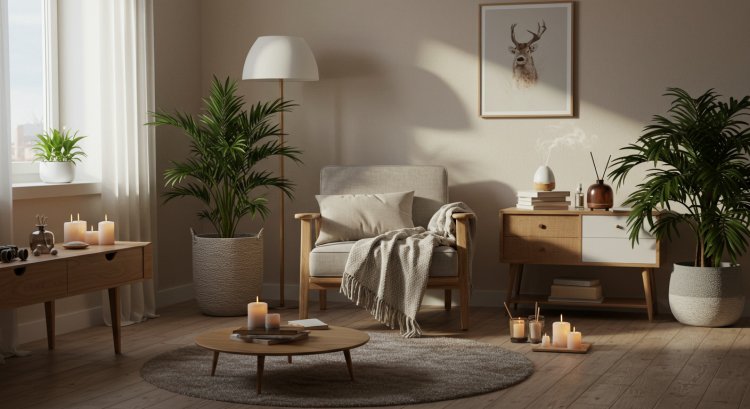How to Create a Relaxing Home Environment for Enhanced Well-Being

In today’s fast-paced world, cultivating a tranquil home environment is essential for overall well-being. Your home should serve as a sanctuary—a space where you can unwind, recharge, and find peace. Achieving this balance involves more than just aesthetics; it requires intentional design choices that foster mental clarity, emotional stability, and physical comfort. This guide explores effective strategies to create a soothing home environment that enhances your well-being.
1. Optimize Natural Light for a Positive Atmosphere
Natural light plays a crucial role in regulating mood, energy levels, and overall health. Exposure to sunlight increases serotonin production, a hormone associated with improved mood and focus. To maximize natural light in your home:
-
Unblock Windows: Keep windows clean and free from heavy drapes. Opt for sheer curtains to allow sunlight to filter in while maintaining privacy.
-
Use Reflective Surfaces: Strategically place mirrors across from windows to amplify natural light and create a more spacious ambiance.
-
Choose Light Color Palettes: Light-colored walls and furnishings, such as soft whites, pastels, and neutrals, enhance brightness and create an open, airy feel.
Pro Tip: Consider installing skylights or larger windows to increase the influx of natural light, boosting both mood and energy levels throughout the day.
2. Integrate Nature for Serenity and Balance
Bringing elements of nature into your home has been scientifically proven to reduce stress, lower blood pressure, and enhance overall happiness. Incorporate nature with these simple steps:
-
Houseplants for Air Quality: Indoor plants like snake plants, peace lilies, and pothos not only enhance aesthetics but also purify the air.
-
Natural Materials: Use organic materials such as wood, bamboo, stone, and cotton in your decor to create an earthy and inviting atmosphere.
-
Soothing Sounds: Introduce calming nature sounds through a small indoor fountain or a sound machine playing gentle rain, ocean waves, or birdsong.
Pro Tip: Select low-maintenance plant varieties if you have a busy schedule—succulents and pothos require minimal care while offering significant benefits.
3. Design Cozy Spaces for Comfort and Reflection
Creating dedicated relaxation spaces within your home allows for moments of solitude and rejuvenation. Consider these ideas:
-
Reading Nook: Arrange a comfortable chair or hammock with plush pillows and a warm throw. Add a bookshelf or side table for your favorite reads and a cup of herbal tea.
-
Meditation Corner: Dedicate a quiet corner to mindfulness practices with floor cushions, scented candles, and calming essential oils like lavender or sandalwood.
-
Soft Textiles and Lighting: Layer your space with soft rugs, cushions, and blankets. Use dimmable lighting to create a warm and inviting atmosphere.
Pro Tip: Position cozy nooks near windows to benefit from natural light, further enhancing the relaxing effect of the space.
4. Declutter for Mental Clarity
A cluttered home can contribute to stress and anxiety, making relaxation more difficult. To maintain a serene and organized environment:
-
Adopt Minimalism: Keep only essential and joy-bringing items, donating or selling unnecessary possessions.
-
Utilize Smart Storage: Incorporate functional storage solutions such as baskets, shelving units, and multi-purpose furniture to keep items neatly stored.
-
Implement a Daily Tidying Routine: Spending a few minutes each day decluttering helps sustain a sense of order and calm.
Pro Tip: Follow the “one in, one out” rule—each time you acquire a new item, remove an old one to maintain balance and avoid unnecessary clutter.
5. Enhance Emotional Well-Being with Aromatherapy
Scent has a profound impact on emotions and mental states. Introducing aromatherapy into your home can promote relaxation, reduce stress, and improve sleep quality. Consider these options:
-
Essential Oils: Lavender, chamomile, and sandalwood promote relaxation, while citrus scents like lemon and orange uplift the mood.
-
Diffusers and Candles: Use essential oil diffusers or natural soy/beeswax candles to create a soothing aromatic experience.
-
Scented Linens and Room Sprays: Lightly mist pillows, bedding, and curtains with calming essential oil blends for a continuous, gentle fragrance.
Pro Tip: Customize essential oil blends based on your needs—lavender and chamomile for relaxation or peppermint and eucalyptus for focus and energy.
6. Choose Calming Colors for a Harmonious Ambiance
The colors you incorporate into your home significantly influence mood and emotional well-being. Soft, neutral shades create a sense of tranquility and balance. Consider the following:
-
Cool Tones: Blues and greens are known for their calming and refreshing effects, making them ideal for bedrooms and living areas.
-
Warm Neutrals: Beige, soft grays, and pale pinks evoke warmth and comfort without overwhelming the senses.
-
Texture and Accents: Introduce textured fabrics and subtle patterns to enhance visual interest while maintaining a serene aesthetic.
Pro Tip: Apply color psychology principles when choosing wall paint—light blue promotes relaxation, while soft green fosters a sense of peace and balance.
Transform Your Home into a Sanctuary
Creating a relaxing home environment extends beyond aesthetics—it’s about designing a space that nurtures your mental, emotional, and physical well-being. By maximizing natural light, integrating nature, designing cozy retreats, decluttering, incorporating aromatherapy, and selecting calming colors, you can transform your home into a true sanctuary.
Ready to enhance your well-being with a serene home environment? Start implementing these strategies today and experience the profound impact on your mind, body, and spirit.












